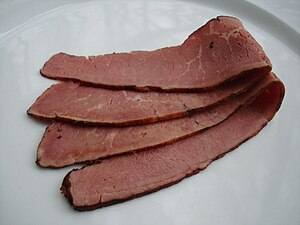Pastrami


Pastrami (Romanian: pastramă, Turkish: pastırma, Yiddish: פּאַסטראָמע pastróme), is a popular delicatessen meat usually made from beef and, traditionally in Romania, also from pork and mutton. In Israel, "Pastrama" is the term used for sliced chicken and turkey. Like corned beef, pastrami was originally created as a way to preserve meat before modern refrigeration. For pastrami, the raw meat is brined, partly dried, seasoned with various herbs and spices, then smoked and steamed. In the United States, although beef navels are the traditional cut of meat for making pastrami, it is now common to see pastrami made from beef brisket, beef round and turkey.
Etymology and origin
Both the dish and the word pastrami originate from the Romanian delicacy pastramă, from which the Yiddish language borrowed it.
According to Romanian sources, the word pastramă itself comes from the Turkish word pastırma (pressed meat),[1] a similar but different specialty (air-dried, unsmoked cured meat). According to other sources, the Romanian term is itself etymologically rooted in the Romanian a păstra, which means "to keep" or "to preserve".[2]
The Romanian specialty was introduced to the United States in a wave of Romanian Jewish immigration from Bessarabia and Romania in the second half of the 19th century, via the Yiddish: פּאַסטראָמע (pronounced pastróme). Early references in English used the spelling "pastrama", closer to the Romanian original. The modified "pastrami" spelling likely was introduced to sound related to the Italian salami.[3]
Although New York's Sussman Volk is generally credited with producing the first pastrami sandwich in 1887, that claim is disputed by the founders of Katz's Deli in New York, which was founded in 1888. Volk, a kosher butcher, claimed he got the recipe from a Romanian friend in exchange for storing the friend's luggage while the friend returned to Romania. According to his descendant, Patricia Volk, Volk prepared pastrami according to the recipe and served it on sandwiches out of his butcher shop. The sandwich was so popular that Volk converted the butcher shop into a restaurant to sell pastrami sandwiches.[4]
Romanian Jews immigrated to New York as early as 1872. Among Jewish Romanians, goose breasts were commonly made into pastrami because they were inexpensive. Beef navels were cheaper than goose meat in America, so the Romanian Jews in America adapted their recipe and began to make the cheaper beef pastrami.
Making foods to sell out of push carts in the Lower East Side of New York was one of the most popular occupations for immigrant Jews in the latter half of the 19th century. Because sandwiches were a hugely popular foodstuff in New York, it is possible Romanian Jewish immigrants were making and selling pastrami sandwiches from push carts on the streets of New York at least a decade before Sussman Volk converted his butcher shop into a restaurant.
The Oxford English Dictionary's Etymology of pastrami, n.[5] quotes a 1914 advertisement from the Jewish Criterion (Pittsburgh)
- Sardines and pimentos‥.Pastrami‥. Rye bread [etc.]
Preparation and serving
Traditional New York pastrami is made from the navel end of the brisket.[6] It is cured in brine, coated with a mix of spices such as garlic, coriander, black pepper, paprika, cloves, allspice, and mustard seed,[7][8] and then smoked. Finally, the meat is steamed until the connective tissues within the meat break down into gelatin.

In North America, pastrami is typically sliced and served hot on rye bread, a classic New York deli sandwich (pastrami on rye), sometimes accompanied by coleslaw and Russian dressing. Pastrami and coleslaw are also combined in a Rachel sandwich, a variation of the popular Reuben sandwich that traditionally uses corned beef and sauerkraut.
At fast food stands in Los Angeles, pastrami is typically served hot on a French roll. Typically, the meat is served sliced very thin with some of the brine wetting the meat. Traditional accompaniments in Southern California include yellow mustard and pickles. Pastrami may also be used as a topping on hamburgers. Classic pastrami sandwiches are usually composed of hot pastrami right out of the steamer, sliced and layered on double-baked Jewish-style rye bread.

Greek immigrants to Salt Lake City in the early 1960s introduced a hamburger topped with pastrami and a special sauce. The pastrami burger has remained a staple of local burger chains in Utah.[9]
Variations
Turkey pastrami is made by processing turkey breast (pale pink) or thigh (dark pink) in a fashion similar to red meat pastrami, simulating the corresponding red meat deli product.
In New York City, the delicatessen Barney Greengrass sells "pastrami salmon," which is essentially a piece of salmon coated in cracked peppercorns and smoked.[10]
See also
References
- Notes
- ^ Dicţionarul explicativ al limbii române, Entry for Pastramă
- ^ pastrami. Dictionary.com. Collins English Dictionary - Complete & Unabridged 10th Edition. HarperCollins Publishers. [1] (accessed: April 09, 2012).
- ^ Harry G. Levine, "Pastrami Land, the Jewish Deli in New York City", Contexts, Summer 2007, p. 68
- ^ Henry Moscow, "The Book of New York Firsts", [2], p. 123
- ^ pastrami, n. Third edition, October 2008; online version November 2010
- ^ Gil Marks, "Encyclopedia of Jewish Food" [3]
- ^ "Pastrami rub": seasoning for pastrami
- ^ Pastrami seasoning mix
- ^ Edge, John T. "Pastrami Meets the Patty in Utah" New York Times (July 28, 2009)
- ^ "Pastrami salmon" on Barney Greengrass store website
